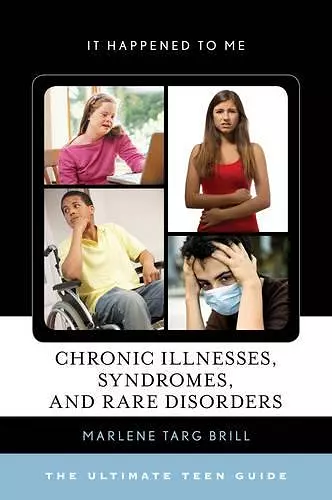Chronic Illnesses, Syndromes, and Rare Disorders
The Ultimate Teen Guide
Format:Hardback
Publisher:Bloomsbury Publishing PLC
Published:4th Aug '16
Currently unavailable, and unfortunately no date known when it will be back

While medical conditions that affect large populations are familiar to most people, there are lesser-known afflictions that do not get attention simply due to the fewer number of those affected. Literature and online resources about these conditions are not only limited but primarily aimed at adults. Consequently, teens who are susceptible to these disorders are often unable to find information that speaks directly to them, which can prove both frustrating and discouraging. In Chronic Illnesses, Syndromes, and Rare Disorders: The Ultimate Teen Guide, Marlene Targ Brill looks at conditions that affect thousands of young adults. Though not quite as common as other medical issues, these afflictions are no less threatening to teens who want to know more. Chapters in this book address ·Celiac disease ·Crohn's disease ·Down syndrome ·Hemophilia ·Melanoma ·Multiple sclerosis ·Phenylketonuria ·Sickle cell disease ·Tourette syndrome In addition to providing specific information about each of these conditions, this book also offers general advice to teens who face medical challenges in general. An invaluable resource for young adults and their families, Chronic Illnesses, Syndromes, and Rare Disorders: The Ultimate Teen Guide offers hope to the many thousands of people looking for answers.
Gr 8 Up-Teens living with a syndrome, chronic illness, or disease too often lack an understanding regarding the challenges they face on a daily basis. This latest addition to the series sheds light on various ailments and dispels common misconceptions. The book covers nine conditions (celiac disease, Crohn's disease, Down syndrome, hemophilia, melanoma, multiple sclerosis, phenylketonuria, sickle cell disease, and Tourette's syndrome). Each chapter begins with an explanation and describes symptoms and how common each one is. When necessary, context is provided; for example, the chapter on Crohn's disease comes with an explanation of the digestive system, while the section on hemophilia discusses clotting factors and how they work. Numerous text boxes highlight first-hand accounts and observations by teens. A brief chronology of the disease throughout history is included when applicable. Tips on managing the condition a are offered, and the final chapter, in addition to covering topics such as bullying, stress relief, and sibling relationships, provides general resources (organizations that help with financial assistance and insurance, medical-related transportation, and housing options during treatment).... [I]t is informative, the writing is accessible, and the content will be truly helpful for teens dealing with the conditions themselves or for those who have a family member or friend affected. * School Library Journal *
This book is recommended because it is unique. It discusses chronic illnesses from a teenager's perspective, a topic I have never come across before. I like that it doesn't sugar coat the diseases and the necessary adaptations teenagers will need to make in their lives to live with a disorder. The diagnostics, treatment, and lifestyle changes are presented as is but in a positive context. It spends a few paragraphs discussing how other teens deal with the, 'Why me?' question but then moves quickly into solutions. The book provides biological information without feeling like you are reading a biology textbook so it is appropriate not only for teens but also for those without a medical background. The science in the book is accurate and current.... Multiple organizations and support groups are listed so people will be able to make contact with at least one of these organizations. I like that there is a glossary and index for quick reference to information within the book. As a science teacher our standards are directly related to the material in the book, genetic disorders. Genetic variability through meiosis was a topic mentioned in this book a few times as well as references to anatomy and physiology. I would use this book every year I teach Biology when we study genetic disorders. Students can also read and understand the material for independent study and research papers since it is written clearly and includes stories from other teenagers. Each chapter is about one particular disorder and is organized with a biological description, symptoms, diagnostic tests, treatment, and lifestyle changes. It is admirable that it acknowledges when scientific knowledge is lacking and admits that we don’t know everything. I believe this work will be a great asset to teenagers who have been diagnosed with a rare or chronic illness. This book is recommended for high school students. * National Science Teachers Association *
ISBN: 9781442251618
Dimensions: 262mm x 183mm x 20mm
Weight: 703g
246 pages